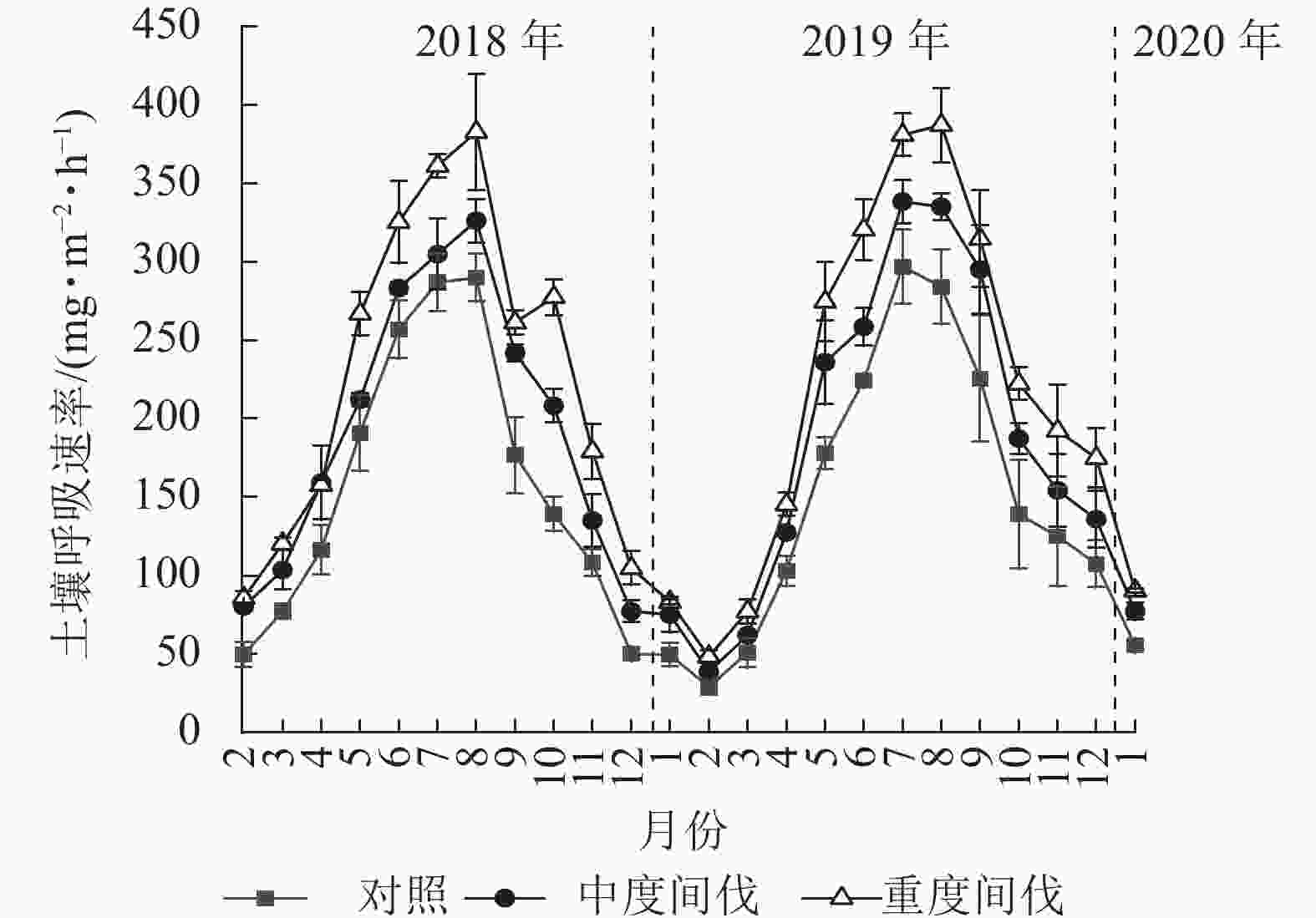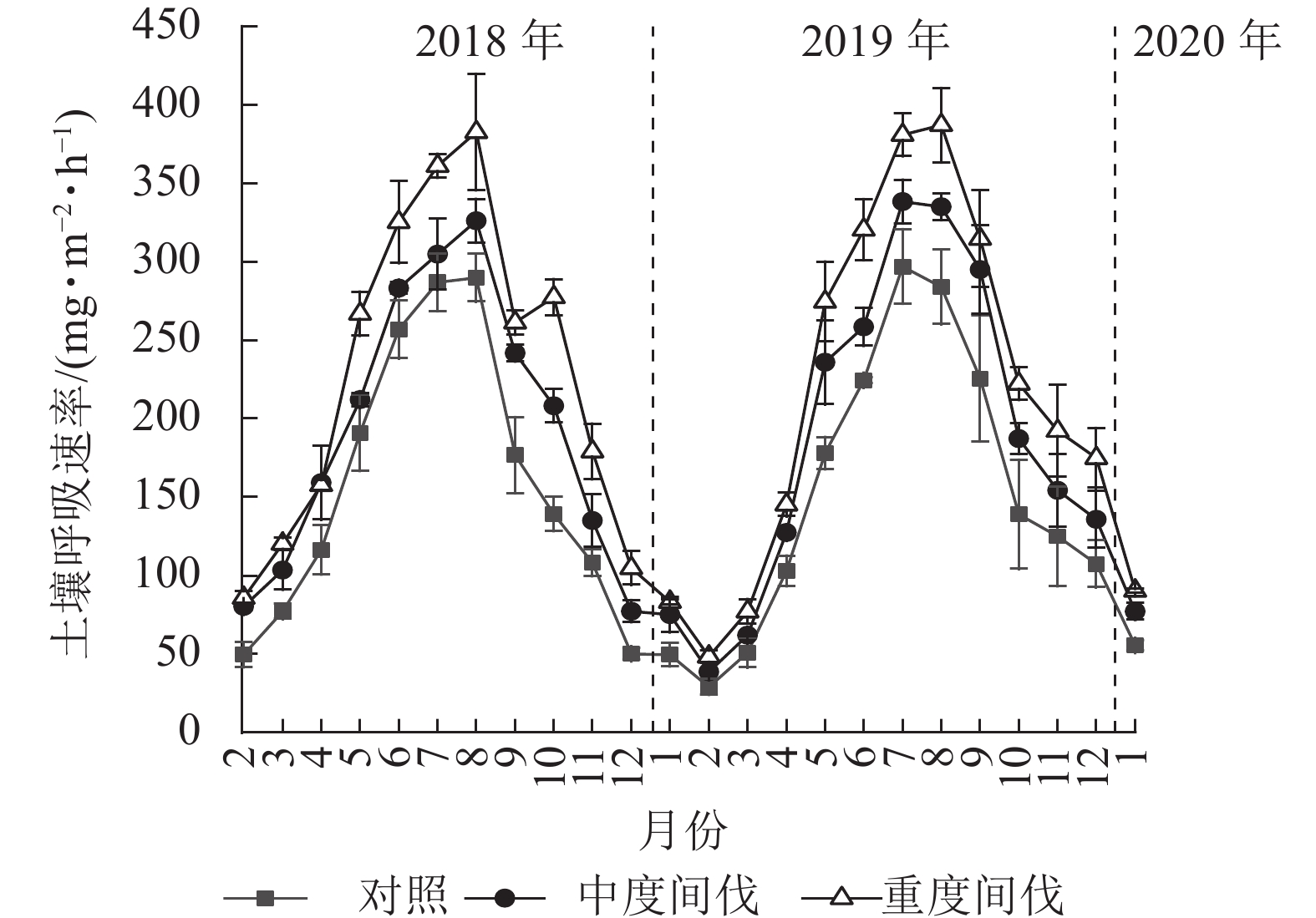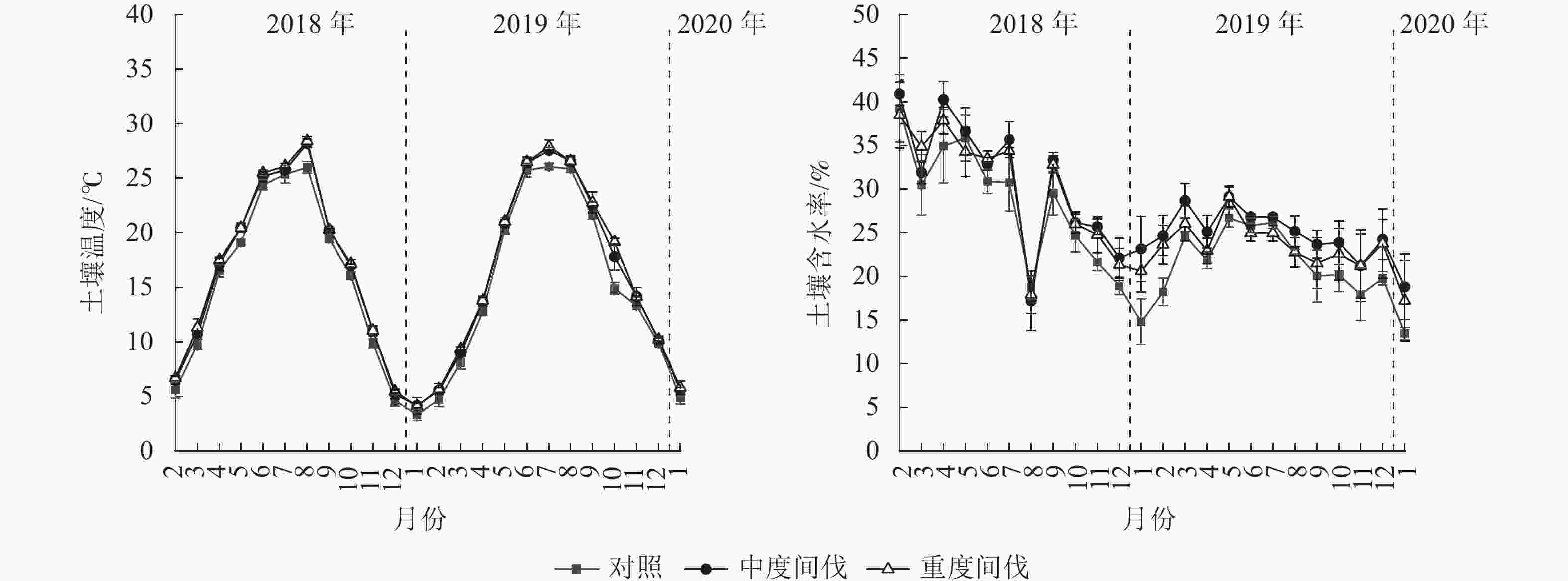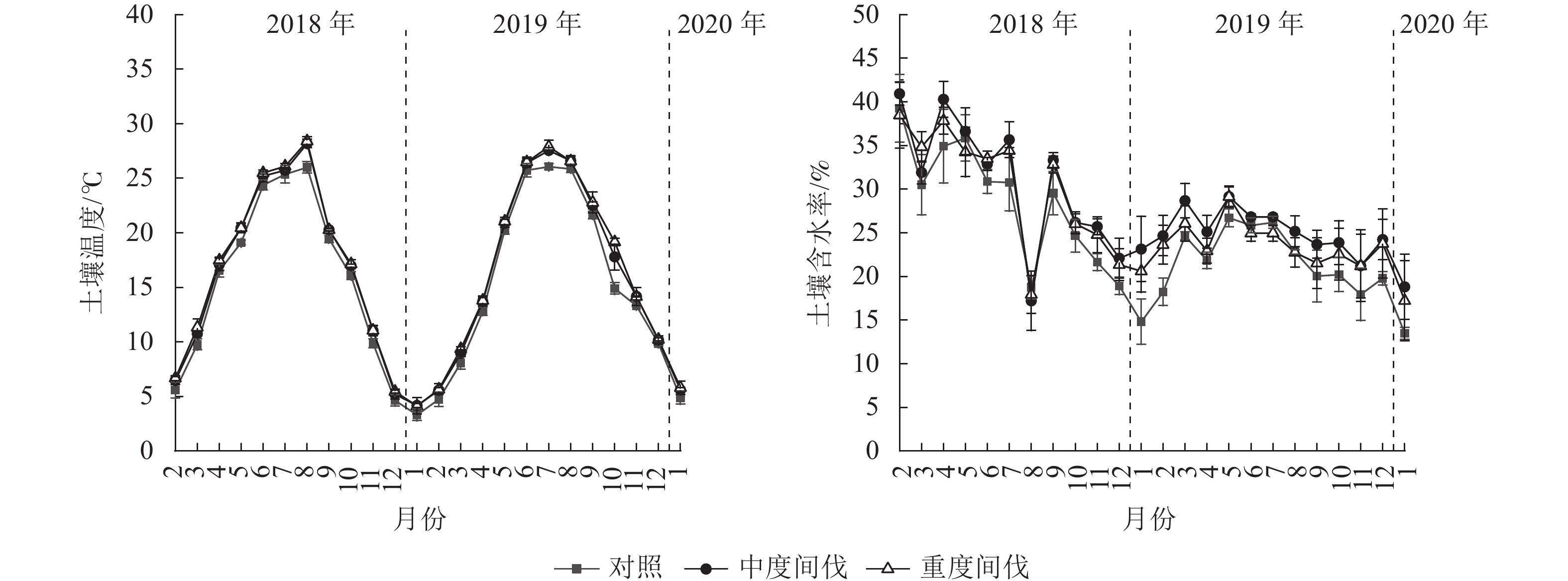-
土壤呼吸是陆地生态系统向大气排放二氧化碳(CO2)的主要途径,在调节生态系统碳循环中发挥着重要作用[1−2]。作为陆地生态系统的主体,森林土壤汇集了全球土壤碳库的73%[3],森林土壤呼吸研究成为陆地生态系统碳循环的研究热点。森林间伐是森林经营的重要措施之一,对促进人工林生长,改善碳固存能力有积极作用,通过改变林地土壤微气候、微生物群落以及根系生长等因子引起森林土壤呼吸变化[4−6]。因此,研究森林间伐对土壤呼吸及其影响机制对评估区域土壤碳循环有重要意义。杉木Cunninghamia lanceolata是中国特有速生丰产的优质树种,其人工林面积高达1 096万 hm2,在缓解木材需求压力、支持天然林保护等生态工程实施方面作用突出[7−9]。杉木人工林因其巨大的固碳潜力,在缓解气候变化上的作用不容忽视[10−11]。然而,由于杉木人工林长期多代连作,引起林地生产力下降、土壤退化,形成了大面积的低质低效杉木林[12]。森林间伐对杉木林土壤呼吸速率的响应结果差异较大。TIAN等[13]研究表明:杉木林土壤呼吸速率随间伐后恢复年限的增加先升高后降低,最终恢复到采伐前水平。LI等[14]研究发现:间伐后第1年杉木林土壤呼吸速率升高,其中异养呼吸增加是土壤呼吸增加的主要原因,但间伐对土壤呼吸的影响随时间推移而减弱。WANG等[15]研究表明:土壤呼吸随间伐强度的增加而增加。丁驰等[16]研究发现:杉木林轻度间伐的土壤呼吸速率显著高于中度和重度间伐处理。然而,探讨间伐对杉木林土壤呼吸的响应时多考虑土壤温湿度的影响,而其他环境因子对土壤呼吸速率的影响仍有待进一步研究。此外,间伐作业对高密度萌生杉木林的土壤呼吸速率影响的研究较少。综上所述,本研究以浙北杉木人工林为研究对象,比较不同间伐强度下森林土壤呼吸速率及其主要影响因子,为杉木林经营及碳汇管理提供科学依据。
-
研究区位于浙江省临安市於潜镇泗州村(30°14′N,119°25′E),该区为典型亚热带季风气候,年均气温为16.2 ℃,最高气温在7—8月,最低气温在1月,年均降水量为1 470.2 mm,降水天数为182.0 d。海拔为40~100 m,样地主要土壤类型为黄壤。杉木林下灌木主要有山茶Camellia japonica、土茯苓Camellia oleifera、菝葜Smilax china等;草本主要有山莓Rubus corchorifolius、金毛耳草Hedyotis Chrysotricha、芒属Miscanthus类植物等。
-
试验地为杉木萌生纯林,该林分是2006年遭受火灾后采伐形成的萌生林,截至2017年12月未进行经营活动。该样地林分密度为4 200株·hm−2,林龄为11 a,林分平均胸径为7.3 cm,平均树高为5.2 m。于2017年12月进行采伐和每木检尺,采用随机区组设计在坡度和坡位相近的杉木纯林设置3种间伐处理,分别为对照(间伐0%)、中度间伐(间伐45%)和重度间伐(间伐70%),每种处理设置3个重复,共设置了9块20 m×20 m的标准样地,样地基本情况见表1。样地0~20 cm土层土壤理化性质:土壤容重为1.07 g·cm−3,土壤有机碳为36.40 g·kg−1,土壤全氮为1.31 g·kg−1,土壤碱解氮为39.51 mg·kg−1,土壤有效磷为1.14 mg·kg−1,土壤速效钾为64.52 mg·kg−1,pH 5.03。
间伐处理 林分密度/(株·hm−2) 平均胸径/cm 平均树高/m 郁闭度/% 伐前 伐后 伐前 伐后 伐前 伐后 伐前 伐后 对照 4 188±45 4 188±45 7.6±0.1 7.6±0.1 5.0±0.1 5.0±0.1 95 95 中度 4 140±225 1 833±55 7.3±0.1 7.8±0.4 5.1±0.1 5.3±0.2 95 62 重度 4 317±114 1 103±48 7.1±0.1 7.4±0.2 4.8±0.2 5.0±0.3 95 38 Table 1. Basic conditions of the plots
于2018年2月至2020年1月,采用静态箱-气象色谱法进行土壤呼吸速率监测,每个样地安置2个30 cm×30 cm×30 cm的PVC静态箱(下坡处静态箱基座没入土壤5 cm),共18个静态箱。每月中旬9:00—11:00采集气体样品。用25 mL注射器分别于密封后的0、10、20、30 min采集气体样品,注入密封的真空气瓶中,带回实验室,48 h内用Agilent 7890气相色谱仪完成测定。
每月采气时,测定静态箱附近土壤5 cm处温度,并采集5 cm处土壤样品使用烘干法测定土壤含水率[16]。每季度采集0~20 cm土层土壤样品,过2 mm筛后,分别风干后置于4 ℃冰箱保存。土壤水溶性有机碳采用水浸提法测定[17],土壤易氧化有机碳采用高锰酸钾氧化法测定[18],土壤微生物生物量碳采用氯仿熏蒸浸提法测定[19],土壤pH采用电位法测定[20]。
-
使用模型拟合土壤呼吸和土壤温湿度的关系,同时估计温度敏感性系数(Q10)。
其中:Rs为土壤呼吸速率(mg·m−2·h−1),T为土壤5 cm土层处温度(℃),M为土壤表层含水率(%),a、b和c为系数参数。
采用SPSS 22.0进行数据统计分析。采用重复观测方差分析(repeated measures ANOVA)检验杉木林土壤呼吸速率与土壤温湿度的差异性,采用单因素方差分析(one-way ANOVA)探讨不同间伐处理下土壤呼吸速率和土壤环境因子差异。利用线性回归分析土壤呼吸速率与土壤环境因子的关系。
-
由图1可知:不同间伐处理的杉木林土壤呼吸速率均呈现明显的季节动态,最高值出现在7—8月,最低值出现在1—2月。从月动态来看,5月开始各间伐处理土壤呼吸速率出现较大差异。对照、中度、重度间伐样地土壤呼吸速率分别为29.09~297.00、38.66~338.31、48.36~387.87 mg·m−2·h−1。间伐显著增加了杉木林土壤呼吸速率(P<0.05),且随着间伐强度的增加而增加。与对照相比,中度和重度间伐土壤呼吸速率分别增加了23.30%、44.94%(表2)。从年际变化看,各间伐处理对土壤呼吸速率无明显差异。

Figure 1. Monthly dynamic of soil respiration rate in C. lanceolata plantation under different thinning treatments
时间 间伐处理 土壤呼吸速率/
(mg·m−2·h−1)土壤温度/℃ 含水率/% 水溶性有机碳/
(mg·kg−1)微生物生物量碳/
(mg·kg−1)易氧化有机碳/
(mg·g−1)间伐后第1年 对照 149.32±2.92 c 15.00±0.19 b 27.54±0.89 a 96.80±2.18 b 266.21±6.84 c 10.74±0.66 b 中度 183.89±5.95 b 15.96±0.10 a 30.49±1.37 a 109.14±4.85 a 295.60±8.19 b 13.30±.0.81 a 重度 217.15±1.79 a 16.16±0.23 a 29.74±1.52 a 119.51±6.16 a 331.07±8.96 a 14.34±0.45 a 间伐后第2年 对照 151.61±6.01 c 15.67±0.23 b 21.47±0.73 a 101.83±1.57 c 244.72±9.71 b 9.28±0.32 b 中度 187.13±6.10 b 16.65±0.22 a 24.85±1.61 a 112.92±3.10 b 282.76±7.20 a 11.69±0.21 a 重度 219.02±2.18 a 16.91±0.29 a 23.39±2.31 a 122.21±2.94 a 307.12±14.35 a 11.73±0.36 a 平均 对照 150.46±1.61 c 15.34±0.15 b 24.51±0.62 a 99.31±1.05 c 255.47±7.01 c 10.01±0.31 b 中度 185.51±5.51 b 16.30±0.15 a 27.67±1.49 a 111.03±3.95 b 289.18±7.29 b 12.49±0.32 a 重度 218.09±1.44 a 16.53±0.26 a 26.56±1.91 a 120.86±3.80 a 319.09±9.62 a 13.04±0.40 a 说明:数值为平均值±标准误。不同字母表示不同处理间差异显著(P<0.05)。间伐后第1年为2018年2月至2019年1月,间伐后第2年为2019年2月至2020年1月。 Table 2. Annual average values of soil respiration rate and environmental factors in C. lanceolata plantation under different thinning treatments
-
各间伐处理的土壤温度表现为春冬季低,夏季高的单峰曲线(图2),间伐处理样地均显著高于对照(P<0.05),与对照相比,中度和重度间伐处理的土壤温度分别增加了6.31%和7.81%(表2)。土壤含水率在间伐第1年(2018年2月至2019年1月)呈现降低趋势,第2年(2019年2月至2020年1月)呈先升高后下降的波动趋势,但各处理土壤含水量差异不显著(P>0.05)。
-
由图3可知:各处理土壤水溶性有机碳质量分数7月最高,1月最低。与对照相比,除间伐第2年的4和10月外,中度和重度间伐处理下土壤水溶性有机碳质量分数均显著增加(P<0.05),分别增加了11.80%和21.70%(表2),间伐处理之间差异不显著。

Figure 3. Seasonal variation of soil active organic carbon in C. lanceolata forest under different treatments
除间伐第2年的4月外,重度间伐处理的土壤易氧化有机碳显著增加(P<0.05);除间伐第1年的4和10月、第2年的4月外,中度间伐处理的土壤易氧化有机碳显著增加(P<0.05)。整体上表现为间伐增加土壤易氧化有机碳质量分数,且与间伐强度无关。与对照相比,中度和重度间伐的土壤易氧化有机碳质量分数分别增加了24.83%和30.27%。
间伐后第1年,与对照相比,随着间伐强度的增加,微生物生物量碳质量分数显著增加(P<0.05)。间伐后第2年除4月外,间伐处理显著增加了微生物生物量碳质量分数(P<0.05)。整体上看,间伐增加了土壤微生物生物量碳,且不同间伐处理间差异显著(P<0.05),中度和重度间伐分别增加了14.01%和24.91%(表2)。
-
从表3可见:间伐后第1年和第2年各处理土壤呼吸速率与土壤温度均呈显著指数相关(P<0.01)。对照的土壤呼吸速率仅间伐第2年与土壤含水率呈正相关(R2=0.268,P<0.01),而间伐处理的土壤呼吸速率与土壤含水率无显著关系。因此,杉木林土壤呼吸速率随着土壤温度的升高而增加,几乎不受土壤含水率的影响。Q10反映土壤呼吸速率对土壤温度变化的敏感性。研究期间,对照、中度、重度间伐的Q10分别为2.10、1.86、1.84,间伐降低了杉木林土壤呼吸的敏感性。
时间 间伐处理 土壤温度 土壤湿度 Q10 a b R2 a b c R2 间伐后第1年 对照 0.252 0.077 0.934** −32.151 18.368 −1.481 0.151 2.16±0.09 中度 0.405 0.059 0.941** 1.251 −1.168 1.393 0.004 1.80±0.05 重度 0.491 0.057 0.882** −23.721 13.159 −0.322 0.034 1.77±0.07 间伐后第2年 对照 0.263 0.072 0.858** 16.971 0.095 0.129 0.268** 2.05±0.12 中度 0.351 0.066 0.884** −56.700 30.036 −2.710 0.067 1.93±0.10 重度 0.408 0.066 0.904** −41.085 21.324 −1.283 0.046 1.93±0.08 总 对照 0.262 0.074 0.904** −35.500 20.339 −1.730 0.192 2.10±0.08 中度 0.377 0.062 0.907** −11.228 6.651 0.238 0.011 1.86±0.06 重度 0.448 0.061 0.891** −26.646 14.972 −0.598 0.040 1.84±0.06 说明:间伐后第1年为2018年2月至2019年1月,间伐后第2年为2019年2月至2020年1月,总表示2018年2月到2020年1月总计。**表示相关极显著(P<0.01)。 Table 3. Regression models of soil respiration rate with soil temperature, moisture and temperature sensitivity (Q10)
各处理杉木林土壤呼吸速率与土壤温度、土壤水溶性有机碳、土壤微生物生物量碳和土壤易氧化有机碳均呈极显著正相关(P<0.01),而与土壤含水率不相关(表4)。由表5可知:土壤温度是影响杉木林土壤呼吸速率的最主要因子。除中度间伐外,土壤易氧化有机碳是影响土壤呼吸速率的次要因子。土壤水溶性有机碳是中度间伐处理下影响土壤呼吸速率的次要因子。
间伐处理 水溶性有机碳 易氧化有机碳 微生物生物量碳 土壤温度 土壤含水率 对照 0.838** 0.903** 0.860** 0.944** 0.201 中度 0.895** 0.850** 0.915** 0.957** 0.028 重度 0.864** 0.897** 0.881** 0.960** 0.014 总计 0.874** 0.885** 0.880** 0.924** 0.106 说明:双尾检验。**表示极显著相关(P<0.01)。 Table 4. Correlation between soil respiration rate and environmental factors
间伐处理 模型 n F R2 P 对照 Rs=0.947xT 24 192.818 0.893 <0.001 Rs=0.689 xT +0.291 xPOXC 24 113.839 0.908 <0.001 Rs =0.890 xT +0.486 xPOXC +0.406 xMBC 24 92.408 0.923 <0.001 中度 Rs =0.967 xT 24 321.305 0.933 <0.001 Rs =0.724 xT +0.293 xWSOC 24 268.603 0.959 <0.001 重度 Rs =0.960 xT 24 261.820 0.919 <0.001 Rs =0.681 xT +0.343 xPOXC 24 267.618 0.959 <0.001 总计 Rs =0.935 xT 72 489.252 0.875 <0.001 Rs =0.630 xT +0.383 xPOXC 72 447.716 0.928 <0.001 Rs =0.580 xT +0.278 xPOXC +0.167 xWSOC 72 322.352 0.934 <0.001 说明:Rs为土壤呼吸速率;xT为土壤温度;xPOXC为土壤易氧化有机碳;xWSOC为土壤水溶性有机碳;xMBC为土壤微生物生物量碳。 Table 5. Multiple regression model of soil respiration rate with environmental factors
-
森林间伐降低了林分密度,对土壤产生强烈扰动,改变了林分结构和土壤理化性质,进而影响土壤呼吸速率[21]。因间伐强度、森林类型、地表植被恢复和气候条件的不同对土壤呼吸影响差异较大,间伐对土壤呼吸速率可能增加、抑制或无影响[22−24]。本研究表明:间伐增加土壤呼吸速率,且随着间伐强度的增加而增加,这与前人在美洲黑杨Populus deltoides林、杉木人工林以及油松Pinus tabuliformis人工林的研究结果一致[15, 25−26]。这是因为间伐降低了林分郁闭度,更多的太阳辐射通过林窗到达地面,林地土壤温度升高,促进土壤有机质的分解和土壤微生物异养呼吸[27]。本研究中,中度和重度间伐处理的土壤温度显著高于对照样地,且各处理土壤温度均与土壤呼吸速率呈显著正相关,这与前人在亚热带杉木林和落叶云杉Picea asperata林的研究结果一致[28−29]。土壤温度作为土壤呼吸速率的主导因子,与土壤呼吸速率呈显著指数关系。随着间伐时间的推移,土壤温度呈现季节性升高和降低,影响林地植物生长代谢的周期性变化,土壤呼吸速率表现为夏季高冬季低的单峰曲线[30]。多元逐步回归结果也表明:土壤温度是影响土壤呼吸的主要因素。本研究中土壤含水率对土壤呼吸速率无显著影响。可能是本研究区降水充沛,土壤水分在整个试验过程变化有限,土壤温度对土壤呼吸变化的强烈影响可能掩盖土壤含水率的影响[31]。另外,林木移除虽然减少了植物的蒸腾散失,但间伐后林地太阳辐射和土壤温度的增加可能促进土壤水分蒸发,减弱土壤水分对土壤呼吸的响应[32]。与对照林分相比,间伐区郁闭度减小,促进了林下植被的恢复进而增加林地土壤根系的自养呼吸[26]。土壤活性有机碳是土壤有机碳中易被生物直接利用转化、最活跃、易氧化的组分,土壤CO2的排放依赖于土壤有机化合物的转化[33]。本研究中,间伐后土壤水溶性有机碳、微生物生物量碳和易氧化有机碳显著增加,且杉木林土壤呼吸速率与土壤各活性有机碳组分均呈显著正相关,这与在杉木林和云南松Pinus yunnanensis林的研究结果一致[34−35]。不同间伐强度的土壤活性有机碳差异是影响土壤呼吸速率的重要原因,间伐初期采伐剩余物输入和死根分解增加了微生物可分解的碳源,林下植被的快速恢复导致植物根系分泌物增多,进而增加了土壤水溶性有机碳质量分数[36−37]。另外,随着采伐后土壤温度的升高,土壤微生物活性提高,加快土壤有机质的矿化,土壤活性有机碳质量分数增加,进而促进土壤呼吸速率增加[38]。土壤呼吸是一系列酶促反应的过程体现,夏季林下适宜的水热环境以及丰富的碳源刺激了土壤微生物活性,这可能是本研究中土壤活性有机碳质量分数夏季较高的原因[39−40]。多元逐步回归分析表明:土壤水溶性有机碳和易氧化有机碳分别是中度和重度间伐的次要影响因子,表明随着间伐对林地干扰程度的增加,影响土壤CO2排放的因子重要性可能发生改变。
Q10作为评估土壤呼吸对全球变暖响应的重要参数,因地理位置、生态系统类型和土壤微生物等不同而不同[16]。在本研究中,与对照相比,间伐处理明显降低了Q10,这与人工油松林和杉阔混交林的研究结果一致[41−42]。研究表明:根系自养呼吸的Q10显著高于异养呼吸[43],Q10的降低可能是间伐后土壤保留的根系减少,自养呼吸减弱导致的[44]。
-
本研究表明:间伐处理显著增加了杉木人工林土壤呼吸速率,且随着间伐强度的增加而增加。间伐处理显著降低土壤Q10。土壤温度是影响土壤呼吸速率的主导因子,土壤活性有机碳是影响土壤呼吸速率的重要因子。
Short-term effects of different thinning intensities on soil respiration rate in the Cunninghamia lanceolata plantation
doi: 10.11833/j.issn.2095-0756.20220704
- Received Date: 2022-11-16
- Accepted Date: 2023-05-24
- Rev Recd Date: 2023-04-20
- Available Online: 2023-09-26
- Publish Date: 2023-09-26
-
Key words:
- Cunninghamia lanceolata plantation /
- thinning intensity /
- soil active organic carbon /
- soil temperature and moisture /
- soil respiration
Abstract:
| Citation: | CHEN Yangen, HU Yanjing, HUANG Sha, et al. Short-term effects of different thinning intensities on soil respiration rate in the Cunninghamia lanceolata plantation[J]. Journal of Zhejiang A&F University, 2023, 40(5): 1054-1062. DOI: 10.11833/j.issn.2095-0756.20220704 |











 DownLoad:
DownLoad:

